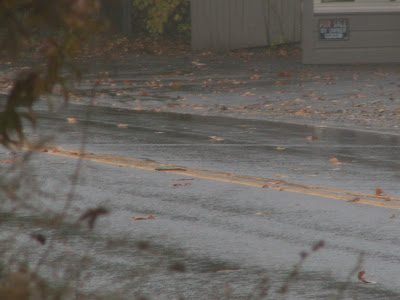There are dangerous traffic conditions at the intersection of Route 212 and Playhouse Lane. What are the options for minimizing these dangerous conditions? Are there any legal instruments available to us now? Since
RUPCO will increase the traffic going home via this intersection by about 500%, is there any way to avoid the inevitable increase in danger at this intersection?
Well, for now, let us stick to the present situation. Let us look at the land use. Playhouse Plaza is a private parking lot. The parking lot is protected from seizure by government, until the land use changes. That means that for as long as Lori's sells coffee by the cups, people will be allowed to pull in to the parking lot, buy a cup, and then back their cars out across one or two lanes of traffic, and be on their merry way. That's just the way it is.
The real question is, can RUPCO ADD to all the cars at this intersection, thereby making the already hazardous conditions there ever more hazardous?
For guidance in this matter, we need look no further than Ulster County itself. The Ulster County Planning Board issued "Access Management Guidelines" in 2003. For those lucky enough to be uninitiated in transportation planning terminology, "access management" is "the process that provides access to land development while simultaneously preserving the flow of traffic on the surrounding road system in terms of safety, capacity, and speed." That definition thanks to the Federal Highway Administration.
The Ulster County document reports three basic transportation techniques for access management: limiting the number of conflict points experienced by a vehicle along the corridor; widen the distance between conflict points that cannot be removed; provide space outside through traffic lanes for slower or stopped vehicles. Now, since the intersection in question is not under construction or renovation, nor can it be, legally, none of these techniques are available to mitigate the dangerous conditions currently present there. So, onto the next set of options.
The report continues to explain that local governments bear the primary burden in access management's success: "Municipalities have substantial regulatory powers available, such as zoning and subdivision approval as well as site plan review to accomplish access management goals once articulated."
Aha, now we are getting somewhere. It is quite clear that municipalities are the places where various interest groups in any project collide, and that it is the municipality that has the power and the responsibility to make sure that access is optimally managed.
Here is an interesting quote from the report: "Access management is most efficient applied early in the planning process and adds little cost." I guess if the intersection in question had been analyzed for safety two or three or five years ago, finding that it is already quite unsafe and that there is no available legal remedy, it would not have evolved into the planning nightmare it appears it might be.
The report goes on to explain the elements of the access management toolbox: driveway control, roadway design, site layout. None of these is relevant to the RUPCO project, since the roadways are fixed, the driveways in question are old and already dangerous, and the site is far from the intersection.
A point of interest is this quote from page 7: "There are a number of typical standards that have been proposed for distances from the edge of an intersection to the first driveway. One principle is that there should be no driveways entering within an intersection's functional area." [boldface type is part of the report.]
Also on page 7 is a table of driveway spacing standards for Canandaigua and Farmington. The gist of this table is the following standard: if the roadway has less than 550 feet BETWEEN driveways, and there are over 301 peak hour trips on the road in question (which there are on Route 212,) then "Communities can and should restrict high traffic volume uses where they cannot be met." ["they" meaning the driveway spacing standards.]
At the intersection in question, there are over 800 peak hour trips, and not only is there not 550 feet between driveways, there is a 180 foot driveway directly across from Playhouse Lane.
It is clear from this directive that the town of Woodstock needs to restrict the high volume use of Route 212, but how, since it is already so heavily used? Hmm. How about limiting the use of Playhouse Lane to its existing users, and not multiplying the number of residents using it by a factor of about five?
How about that.
On the last page of the Access Management Guidelines for Ulster County, under Implementation Techniques, is the following:
"Municipalities can require that access management techniques be initiated for land use actions in developed areas. One way to accomplish this is to require a review of site plans and special permits when there is a change in ownership or land use. It is also important to understand the position of NYSDOT and Ulster County Highway Department in this process. These agencies often lack the authority to require improvements at these times but are highly desirous of implementing these techniques and more than willing to provide design assistance along with the necessary permits once they are required by the community. To facilitate this, communities should engage these agencies in a cooperative dialogue rather than have the applicant serve as a go between."
This says that the town needs to assess and take responsibility for coordinating the various levels of government involved in keeping the roads safe. They cannot and should not pass the buck simply because they do not have total authority to achieve a given end.




